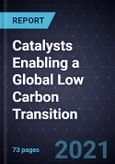Need for Cost-effective, High-performance Production Processes towards Achieving a Circular Economy Drives Strategic Partnering
The role of catalysts in renewable energy generation, such as solar-to-energy, green hydrogen, power-to-X, and waste-to-fuel, is focused primarily on increasing the efficiency rates while reducing heat loss. In solar energy generated through solar panels, catalysts help enhance the energy being absorbed and transported across the solar panels. In applications such as carbon/methane conversion and grey and blue hydrogen generation, catalysts optimize the conversion rate while reducing harmful by-product generation, such as methane or carbon monoxide.
Catalyst technology can help address the increasing demand for clean energy by boosting the efficiency of solar and wind energy. Moreover, technology developments focused on creating catalysts from recyclable or natural materials and/or making them bio-degradable can support the sustainability practices in various industries.
The use of catalysts in various processes can reduce the operating temperature, eventually decreasing energy consumption and providing stability, which reduces the risk of heat loss and the emission of harmful by-products in low-carbon applications. For many years, technology developers focused on delivering low cost and sustainable alternatives within catalysis processes for technologies such as carbon conversion, hydrogen generation, and solar energy to ensure a smooth low carbon transition.
Catalysts are available in 4 types, namely homogenous, heterogeneous, mixed, and biocatalysts. The first 2 catalysts are widely commercialized and already in use for low-carbon applications while the other 2 remain in the early stages of development and adoption.
Emerging technologies, such as nanocatalysts and photocatalysts, have shown the potential to reduce maintenance costs as they offer high stability and durability as well as enhance the rate of reaction. However, understanding the safety of adopting these catalysts within low-carbon applications remains limited.
Studies indicate that the doping of metal oxides and rare earth metals can enhance the durability of any given catalyst as well as increase the active sites of the catalyst due to their porous structure. These doped catalysts have been tested in hydrogen generation and utilization. These catalysts have also shown high stability with minimal maintenance needed in the generation of hydrogen energy from seawater.
In the carbon/methane conversion process, transition metal-based catalysts have proven to reduce the operating temperature while enhancing the conversion rate. As for waste-to-fuel applications, photocatalysts are effective, even in alkaline solutions.
This research is intended to answer the following questions:
- How important are catalysts for low carbon transition?
- What are the various types of current and emerging catalytic technologies and their intended applications?
- What are the benefits and limitations of catalysts that influence their adoption in low carbon transition?
- What are the various R&D efforts by industry participants aimed at accelerating the adoption of catalysts in the low carbon transition?








